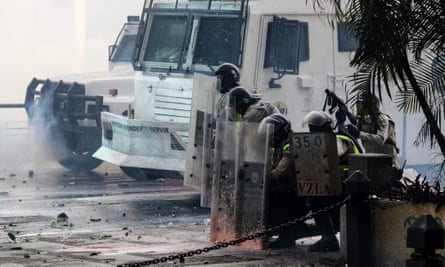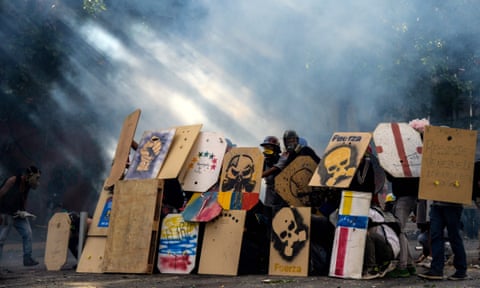It starts with a distant rumble, and then a chanted countdown from the demonstrators packed tight along the Caracas freeway.
As the count reaches zero, the crowds briefly part, and a file of young protesters – faces covered by T-shirts or makeshift gas masks – rush forward to confront heavily armed riot police.
Shots ring out, and plumes of teargas arch towards the protesters. Some shelter behind wooden shields; other return the gas canisters or throw Molotov cocktails. After a few minutes, the first wave returns to the crowd, coughing and spitting – and a new cohort rushes forward to take their place.
After nearly two months of political unrest in Venezuela, a pattern has emerged at the near daily protests that have erupted across the country.
Anti-government demonstrations begin with a peaceful march, in which hundreds of thousands head towards government buildings in central Caracas, demanding fresh elections and an end to chronic shortages of food and medicine. They never reach their destination.
Somewhere along the route, the road is blocked by a line of national guardsmen armed with rubber bullets and teargas, and backed by water cannon. After a brief standoff, the countdown starts – and the rioting begins.
Why is there unrest in Venezuela?
• At the heart of the crisis is a cratering economy and acute shortages of medicine and food, coupled with rising anger at a soaring crime rate and an increasingly authoritarian government
• The president, Nicolás Maduro, won a general election in 2013 on a platform of continuing his predecessor Hugo Chávez's socialist policies of using the country's oil riches to reduce inequality and lift people out of poverty, but falling oil prices have forced the government to curtail social programmes
• Opposition activists have been staging unrelenting protests against the government. On 26 June a wave of lawlessness that began in the city of Maracay marked the first time that street clashes have spread into more generalised anarchy
At times, the clashes resemble scenes from Braveheart or Gladiator, with security forces with shotguns and body armour battling ragtag protesters with catapults and improvised shields.
It is an unequal fight, but the young firebrands – known as los chamos after the Venezuelan slang for kids – are increasingly dominating the daily protests. State television dismisses them as rioters, but every day new cellphone footage of the clashes is widely shared on social media.
Some activists say that the young protesters are the opposition’s best hope at galvanizing the resistance and even pushing the demoralized military to shift loyalties.

On Wednesday the streets of eastern Caracas were once again engulfed in the blueish fog of teargas after the pro-government electoral council announced a timetable to redraft the constitution and delay regular elections until the end of the year.
Pausing between clashes, Andres Muñoz, an engineering student in his final semester who barely managed to escape, explained that it was the authorities’ disproportionate use of force that keeps him protesting.
“I know that my main duty is to prepare myself for a better future – and that is precisely why I am protesting,” said Muñoz, who asked to be identified with a pseudonym for fear of reprisals. “This is as much a part of my future as my studies.”
Muñoz said that at the same march he saw one man struck in the head by a teargas canister. “I don’t believe in violence but we are reacting to their abuse,” he said, before heading back to the frontline.
Others are concerned that such tactics will inevitably lead to more violence.
“Many of them are young – and they’re angry at being without a job or a sense that the future will offer them opportunities,” said a lawyer as she watched another skirmish last week. “I worry that if things don’t change for the better, we’ll be left with a group of kids who for the last two months learned how to attack security forces – and are now even more frustrated.”
The government of president Nicolás Maduro goes a step further. High-ranking officials have called the young protesters “terrorists” and claim they are organized and paid by the extreme right. Others say the young men – and a few women – on the frontline are being used as cannon fodder by opposition leaders.
The country’s chief prosecutor said on Wednesday that 55 people had been killed and about 1,000 injured in the latest wave of political unrest, which was triggered in March by Maduro’s efforts to consolidate his rule.
Luisa Ortega Díaz – one of the most senior officials to speak out against the government – accused security officers of excessive force and said that at least one person had been killed by a teargas canister fired from close range.
Protesters have hurled Molotov cocktails and fired catapults; they have also been shot and run over by water cannon.
Those in the thick of the street fighting say that the deaths have only strengthened their resolve.
“I didn’t know any of [the victims] but their deaths hurt me like they were my brothers,” said an accounting student, who asked not to be named. “At first, I wanted to stop protesting. I still do. I am tired. But I know I can’t give up until we recover our country.”

After seven weeks of clashes, los chamos have become more organized and better equipped: where once they entered the fray with swimming goggles and dust masks, and carrying improvised shields made from wood or even satellite dishes, now they wear gas masks and construction helmets, and shelter behind shields made from sawn-off oil drums.
Many wear a single glove so that they can retrieve and return teargas canisters without getting burned.
“You never study how to protest and nobody has trained us, but you learn how to take care of yourself as you go,” said another student.
Slingshots and stones are giving way to petrol bombs, and for a brief period earlier this month even “poopootov cocktails” – bags full of water and faeces that are hurled at the security forces.
Even some opposition activists have expressed disgust at that tactic. “It might seem like a joke, but the emotional impact of being splattered in shit after fighting kids for eight hours under the sun in riot gear is not to be underestimated,” said a retired armed forces officer who asked not to be named. “These [officers] are guys who suffer from the same economic crisis that the rest of the country and who will likely go back home to little food, or even no soap to wash off.”

The minister of the interior, Nestor Reverol, cited the use of such weapons to justify a growing trend to try protesters in military tribunals. “Military courts will be in charge of all investigations that are necessary of these terrorists hired by the right,” he wrote on Twitter.
Thousands have been detained and nearly 120 people are being tried in military courts, according to Human Rights Watch.
Amnesty International argues that the use of such tribunals reflects a government that is willing to tighten its grip. “The Venezuelan government is moving yet further away from the realm of legality. International law clearly establishes that it is unacceptable to treat civilians in the same way as the military, and is a total infringement on the exercise of human rights,” it wrote.
But others believe it is a sign that the government no longer has the support of a judicial branch that in previous waves of protests jailed hundreds of students and activists.
Few on the frontline are likely to be deterred by the threat of prison.
“According to the constitution, it is my right to protest,” said Muñoz. “If the government wants to deny me that right then they force me to resist.”









